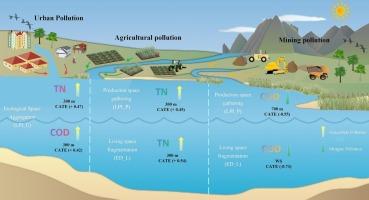从相关到因果:高原湖盆景观-水质响应的因果机制、尺度依赖和结构-功能失配
IF 7
2区 环境科学与生态学
Q1 ENVIRONMENTAL SCIENCES
引用次数: 0
摘要
解读景观格局对水质的因果关系对流域管理至关重要,但大多数研究仅限于相关性分析,无法提供可靠的因果证据,特别是在复杂人为压力下的敏感高原湖泊流域。本文以具有全球代表性的抚仙湖流域为例,构建了生产-生活-生态空间、景观结构与水质响应(PLES-LS-WQ)一体化分析框架。将机器学习(XGBoost-SHAP)和因果推理模型(causal Forest)与土地利用情景模拟(PLUS模型)相结合,量化多尺度、多情景下关键景观格局因子对水质(TN、TP、COD)的真实因果效应。结果挑战了几个传统假设:(1)揭示了显著的语境依赖。景观格局的因果效应不是固定的,而是由主要污染源(采矿、城市或农业)决定的。例如,生产空间的聚集改善了矿区的水质,但使农业区的水质恶化。(2)本研究首次提供了结构-功能失配的因果证据。与传统的生态连通性是有益的观点相反,高污染负荷(采矿和城市)下的集群生态空间对水质产生了显著的负向因果效应,表明其物理结构未能转化为生态净化功能,甚至促进了污染物的运输。(3)规模分析和情景模拟进一步表明,忽视情境依赖和功能失配可能导致管理失败甚至不良后果。通过提供强有力的因果证据,该研究提出了流域管理的范式转变,从追求普遍的结构优化转向具体环境的、以功能为导向的方法。本文章由计算机程序翻译,如有差异,请以英文原文为准。

From correlation to causation: Causal mechanisms, scale dependency, and structure–function mismatch in landscape-water quality responses in plateau lake basins
Deciphering the causal effects of landscape patterns on water quality is critical for watershed management, yet most studies are confined to correlation analyses that fail to provide reliable causal evidence, particularly in sensitive plateau lake basins under compounded anthropogenic pressures. Taking the globally representative Fuxian Lake basin as a case study, this study developed an integrated analytical framework of production-living-ecological spaces, landscape structure, and water quality response (PLES-LS-WQ). Machine learning (XGBoost-SHAP) and causal inference model (Causal Forest) were combined with land-use scenario simulation (PLUS model) to quantify the true causal effects of key landscape pattern factors on water quality (TN, TP, COD) across multiple scales and scenarios. The results challenged several conventional assumptions: (1) Significant context dependency was revealed. The causal effects of landscape patterns were not fixed but determined by the dominant pollution source (mining, urban, or agricultural). For instance, the aggregation of production space improves water quality in mining-dominated areas but degrades it in agricultural zones. (2) The study provided the first causal evidence for a structure–function mismatch. Contrary to the traditional belief that ecological connectivity is beneficial, clustered ecological spaces under high pollution loads (mining and urban) exerted significant negative causal effects on water quality, indicating that their physical structure failed to translate into ecological purification functions and even facilitated pollutant transport. (3) Scale analysis and scenario simulation further indicated that ignoring context dependency and functional mismatch may lead to management failure or even adverse outcomes. By providing robust causal evidence, the study argued for a paradigm shift in watershed management from the pursuit of universal structural optimization towards a context-specific, function-oriented approach.
求助全文
通过发布文献求助,成功后即可免费获取论文全文。
去求助
来源期刊

Ecological Indicators
环境科学-环境科学
CiteScore
11.80
自引率
8.70%
发文量
1163
审稿时长
78 days
期刊介绍:
The ultimate aim of Ecological Indicators is to integrate the monitoring and assessment of ecological and environmental indicators with management practices. The journal provides a forum for the discussion of the applied scientific development and review of traditional indicator approaches as well as for theoretical, modelling and quantitative applications such as index development. Research into the following areas will be published.
• All aspects of ecological and environmental indicators and indices.
• New indicators, and new approaches and methods for indicator development, testing and use.
• Development and modelling of indices, e.g. application of indicator suites across multiple scales and resources.
• Analysis and research of resource, system- and scale-specific indicators.
• Methods for integration of social and other valuation metrics for the production of scientifically rigorous and politically-relevant assessments using indicator-based monitoring and assessment programs.
• How research indicators can be transformed into direct application for management purposes.
• Broader assessment objectives and methods, e.g. biodiversity, biological integrity, and sustainability, through the use of indicators.
• Resource-specific indicators such as landscape, agroecosystems, forests, wetlands, etc.
 求助内容:
求助内容: 应助结果提醒方式:
应助结果提醒方式:


